Introductory remarks: Cretaceous Foramifera
Along the inner carbonate platform environments of the rifted western and eastern margins of the Cretaceous Tethys, the complex and partitioned litulids of the suborder Textulariina continued to dominate, even though more than a third of all benthic foraminifera became extinct toward the end of the Jurassic. Many of these species that thrived during the Cretaceous have limited stratigraphic ranges, therefore, they are valuable as index fossils. In the Early to Middle Cretaceous, a new group appeared called the alveolinids (miliolines). Many of these alveolinids resembled the planispiral-fusiform fusulinines of the Permian. By the Cenomanian, larger miliolines played an important role in the assemblages of carbonate platforms. By the Late Cretaceous new, simple rotaliines evolved into forms with complicated three-layered structures, called the orbioids. The orbiloids showed provincialism and some were only found in the Caribbean, in contrast to the other Cretaceous forms that dominated the Tethys region.
This page aims to summarize the taxonomy of the most significant large benthic foraminifera that appeared during the Cretaceous. The major four suborders that thrived during the Cretaceous are:
Involutinina, Textulariina, Miliolina and
Rotaliina (see figure below).
Superfamilies, families and genera of these suborders will be discussed following the text of
Dr. Marcelle K. BouDagher-Fadel of the University College of London (University College of London - MIRACLE). Chapter 5 of BouDagher-Fadel (2008) presents a comprehensive overview of the main genera of the Cretaceous larger foraminifera and prominent researchers, evolutionary lineages and phylogenetic relationships, biostratigraphic ages and paleoenvironmental interpretations.
The evolution of the Cretaceous suborders (thick lines) and superfamilies (thin lines) of the larger foraminifera (BouDagher-Fadel, 2008, pg. 216)
SUBORDER INVOLUTININA
- Test: all forms have enrolled second chamber. Umbilical region has pillar-like structures on one or both sides of the test
- Walls: aragonitic, but typically recrystallized to give a homogenous microgranular structures.
- Geologic range: Early Permian to Late Cretaceous.
Superfamily INVOLUTINOIDEA
Note: all genera of this superfamily originated during the Jurassic or earlier, therefore, are discussed on previous pages
- Test: First chamber followed by a planispiral to trochospiral enrolled tubular second chamber
- Geologic range: Early Permian to Late Cretaceous
SUBORDER TEXTULARIINA
- Test: agglutinated; tests are made of foreign particles bound by organic cement
- Geologic range: Early Cambrian to Holocene
Superfamily NEZZAZATOIDEA
- Test: trochospiral or planispiral, later occasionally uncoiled
- Wall: simple non-lamellar, microgranular and may possess internal plates or simple partition
- Aperture: simple or multiple
- Geologic range: Cretaceous to Holocene
Family Nezzazatidae
- Test: trochospiral or planispiral, later occasionally uncoiled
- Aperture: single or multiple with internal toothplate
- Geologic range: Cretaceous
Subfamily Nezzazatinae
- Test: trochospiral or planispiral, later occasionally uncoiled. Interior of each chamber has internal plate and is basally digitate
- Aperture: single or multiple
- Geologic range: Cretaceous
![]() 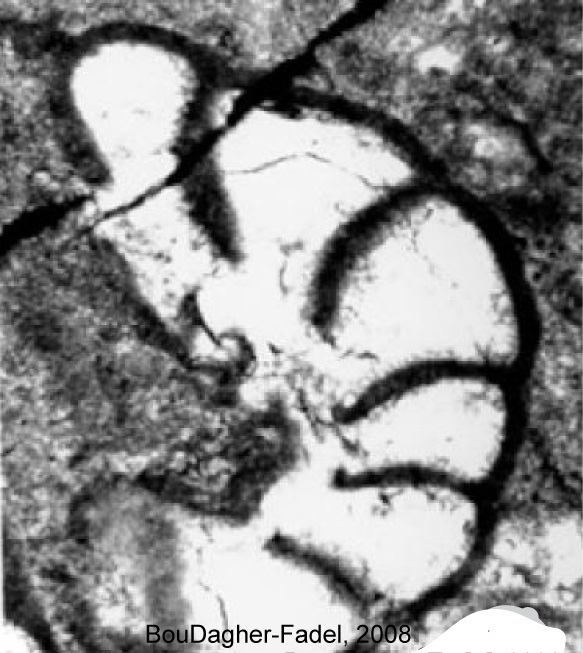 |
Test: trochospiral with a closed umbilicus. A narrow plate extends back from one septum to the previous one. Aperture: single, extending from the umbilicus to the periphery, then bending sharply with an apertural tooth.
Geologic range: Cretaceous
|
![]() 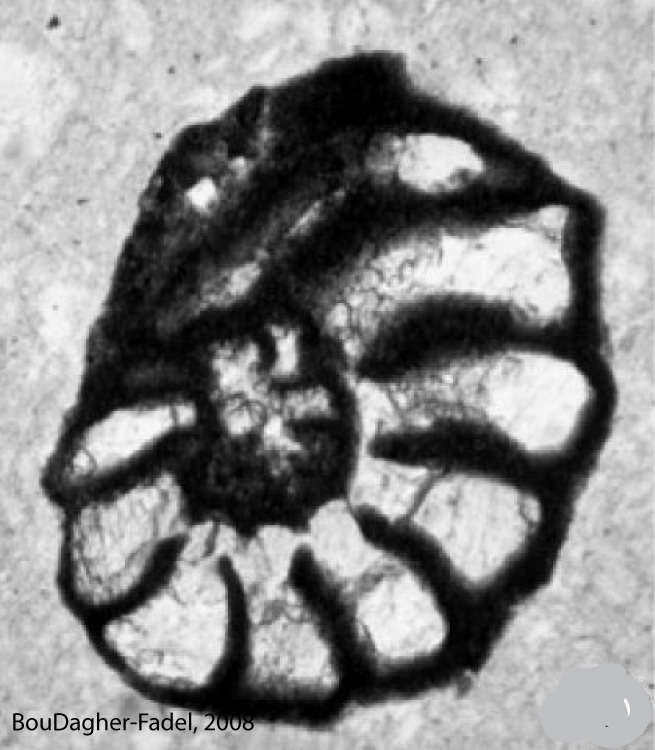 |
Test:a low trochospiral, with a flattened spiral
side, and the opposite side convex and involute. The chambers in the final whorl are narrow, elongate, with the final chamber flaring backwards. Aperture: a large
curved slit, may be accompanied by secondary apertures either in a curved row or scattered over the apertural face.
Geologic range: Cretaceous
|
Subfamily Coxitinae
- Test: trochospiral or planispiral with internal median lane between conseccutive septa, the plates being terminally bifurcate or digitate.
- Aperture: multiple
- Geologic Range: Cenomanian to Maastrichtian
![]() 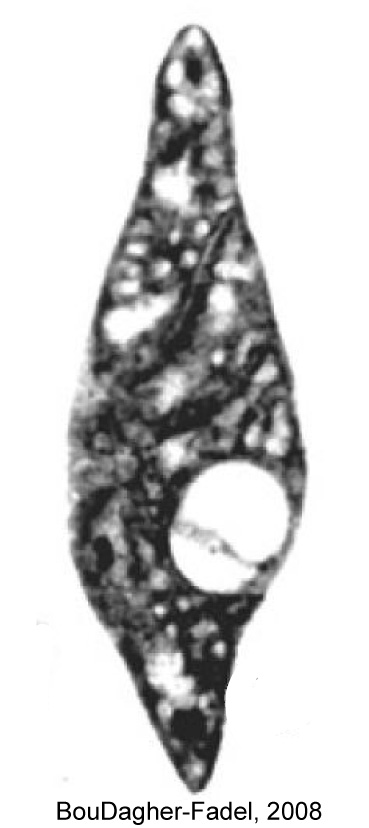 |
Test: trochospiral with a bilocular embryonal stage, followed by numerous low chambers, that are oblique on the spiral side and strongly arched on the umbilical side around a central depression. Incomplete partitions within the chambers parallel to the septa. Aperture: multiple.
Geologic range: Cretaceous
|
![]() 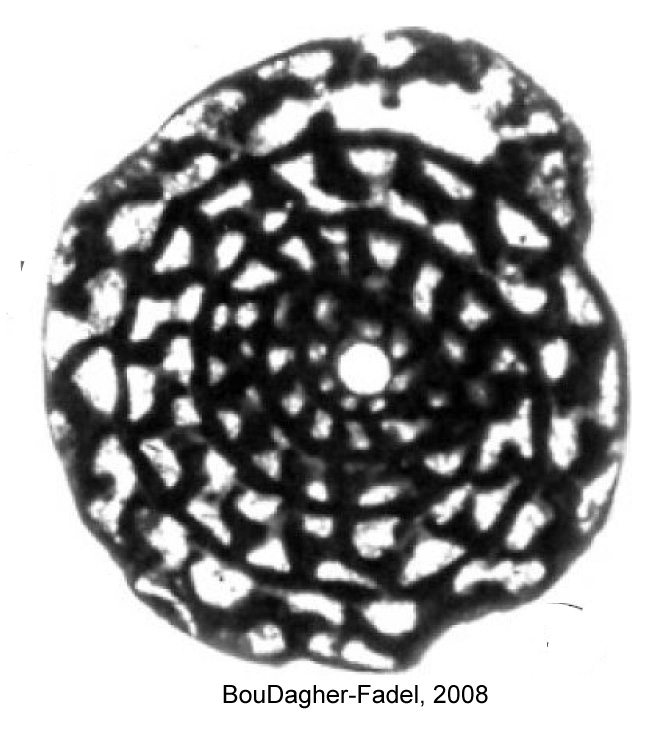 |
Test: planoconvex, trochospiral to completely involute. A perforated plate within the adult chamber parallels the spiral wall but twists and is attached to both chamber floor and roof.
Geologic range: Cretaceous
|
Family Mayncinidae
- Test: biumbilicate or very compressed, planispirally enrolled, rarely uncoiling. Chambers increase rapidly in height.
- Septa: monolamella
- Wall: simple, solid and microgranular
- Geologic Range: Late Jurassic to Late Cretaceous
![]() 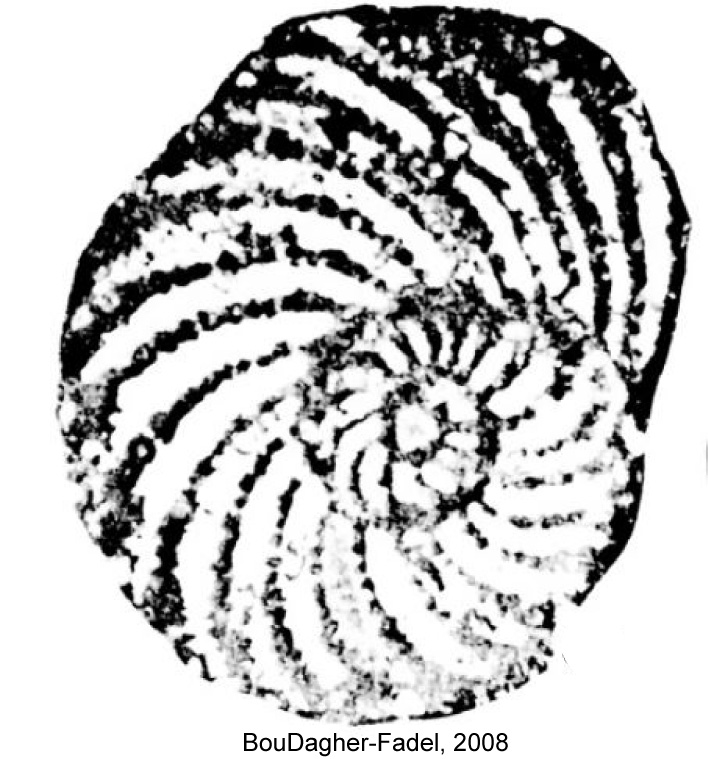 |
Aperture: multiple in vertical rows.
Geologic range: Late Cretaceous
|
![]() 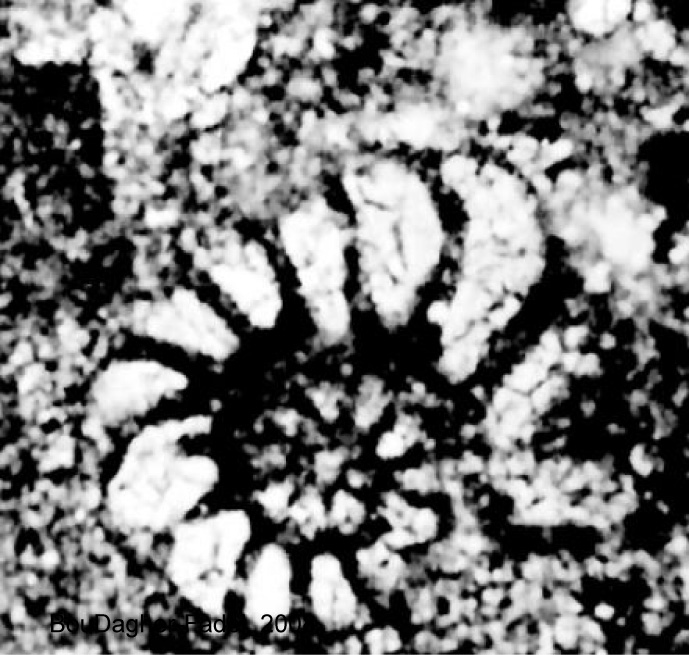 |
Aperture: multiple scattered.
Geologic range: Cretaceous
|
![]() 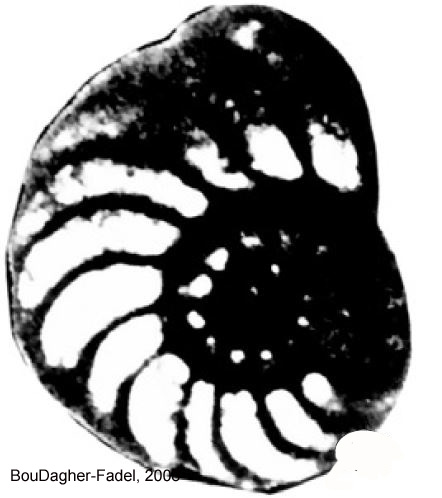 |
Test: This form is similar to Daxia (see Jurassic forams page) but with an extensive slit-like aperture.
Geologic range: Early Cretaceous
|
Superfamily BIOKOVINOIDEA
- Test: free, with a trochospiral or planispiral early stage, that later may become uncoiled
- Septa: homogenous and massive
- Aperture: basal tto areal, and single to multiple
- Geologic Range: Early Jurassic to Late Cretaceous
Family Charentiidae
- Test: early stage planispiral
- Wall: finely canaliculated
- Aperture: single or multiple
- Geologic range: Middle Jurassic to Late Cretaceous
- Genera: Charentia; Debarina
Superfamily LITUOLOIDAE
- Test: multilocular, rectilinear and uniserial. Wall: may be alveolar. The early stage has plani- (strepto-) or trochospiral coiling. The periphery of the chambers have radial partitions; centrally with or without scattered, separated pillars.
- Aperture: simple or multiple cribrate, with no toothplate
- Geologic Range: Early Jurassic to Holocene
Family Everticylamminidae
- Test: streptosprial or planispiral in early stage, uncoiled in the adult or uniserial throughout
- Wall: microgranular with an alveolar microstructure.
- Interior of chambers: simple
- Aperture: areal
- Geologic Range: Early Jurassic to Cretaceous
![]() 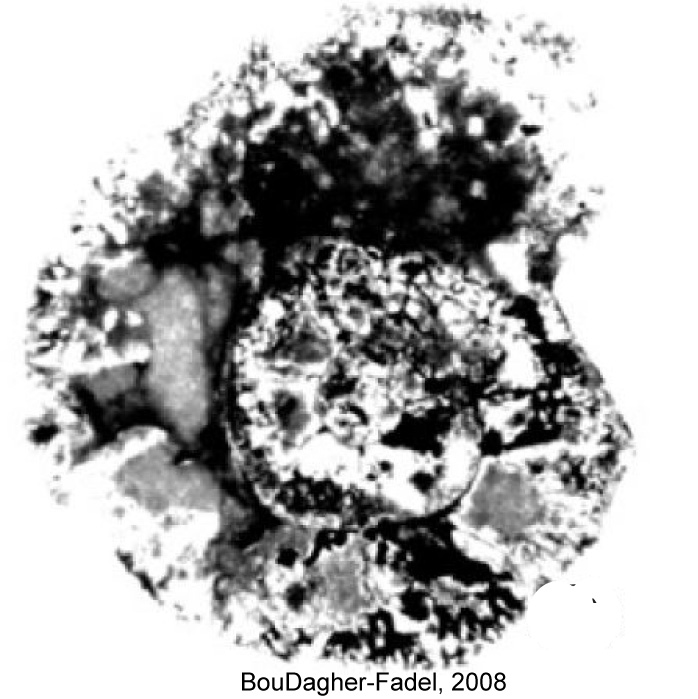 |
Test: planispiral, with a single aperture occupying
all, or nearly all, of the total height of the apertural face in equatorial section, reducing the solid septa which are clearly different in structure from spiral wall. The basal layer is deposited over chamber floors.
Geologic range: Cretaceous
|
![]() 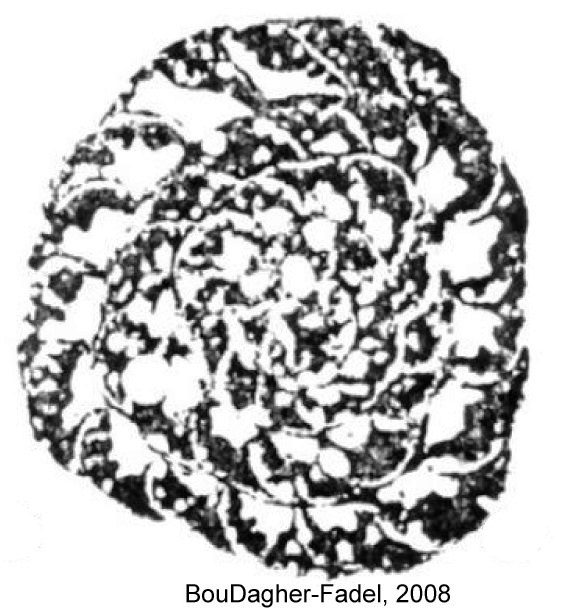 |
Test: evolute, biumbilicate, loosely coiled
in a low, almost planar streptospire.
Geologic range: Early Cretaceous
|
Family Hauraniidae
- Test: uncoiled, unserial or planispirally coiled
- Wall: microgranular, with hypodermic network
- Septa: simple or with complicated microstructres.
- Interior of chambers: simple or with pillars
- Aperture: multiple
- Geologic range: Jurassic to Cretaceous
Subfamily Amijellinae
- Test: uncoiled or planispirally coiled
- Septa: simple or with a complicated microstructure
- Interior of chambers: simple, but some genera may develop pillars
- Wall: may have alveoles
- Aperture: multiple
- Geologic range: Jurassic to Cretaceous
![]() 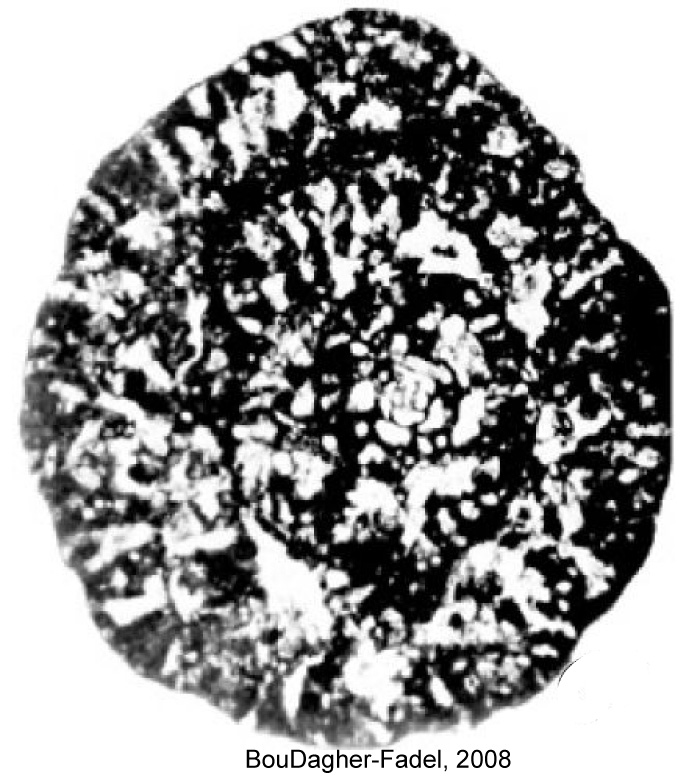 |
Test: coiled, nautiliform, with a central zone having
delicate pillars bridging from septum to septum.
Geologic range: Late Cretaceous
|
![]() 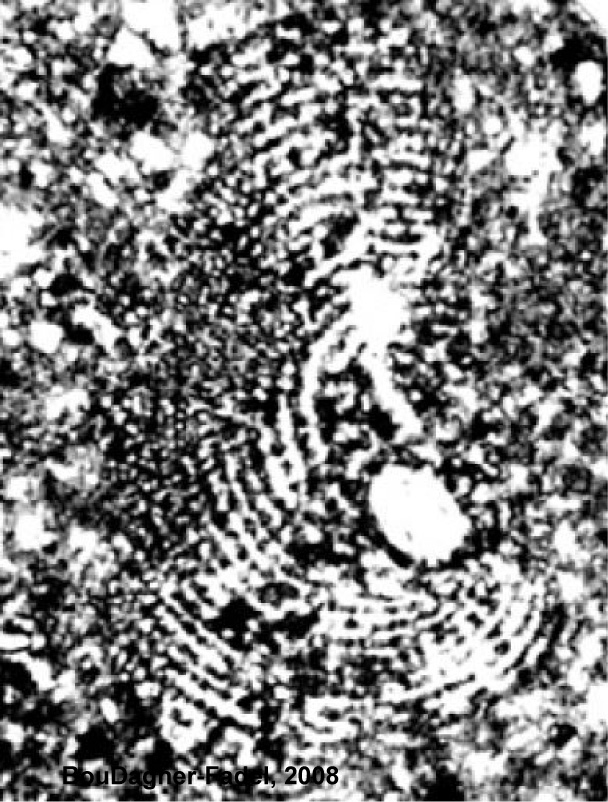 |
Test: central pillars span
flabelliform chambers. Finely reticulate hypodermal mesh, with beams below
Geologic range: Late Cretaceous
|
![]() 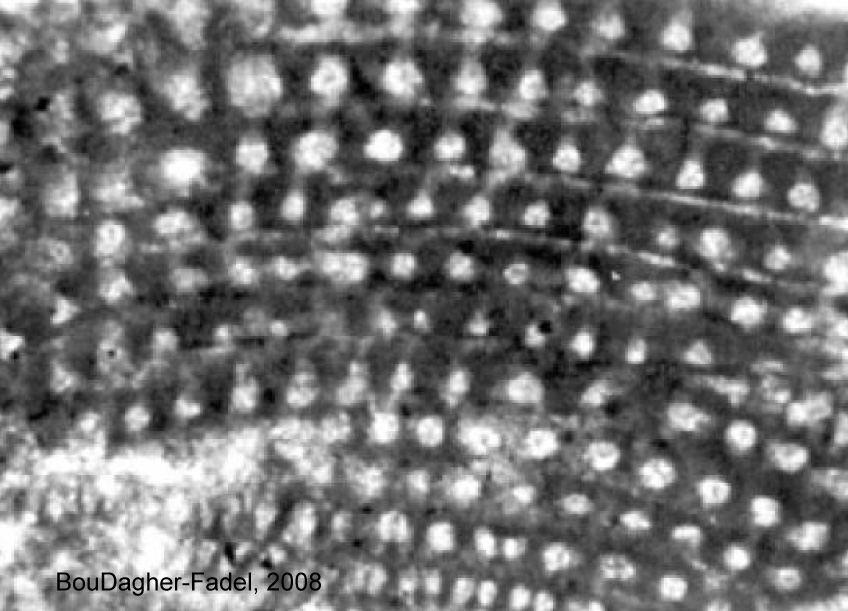 |
Test: early stage planispiral, later chambers cyclical. The outer parts of the chambers are subdivided into numerous small chamberlets
Geologic range: Late Cretaceous
|
![]() 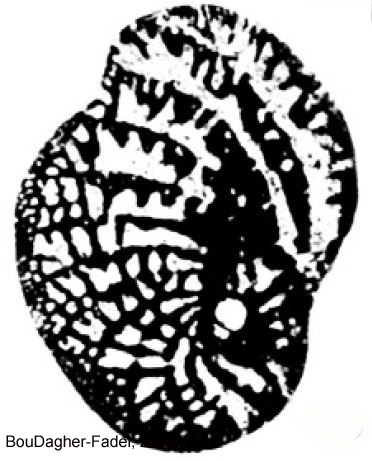 |
Wall: has a subepidermal meshwork. Chambers: subdivided into small chamberlets by bifurcating septula perpendicular to the septa
Geologic range: Late Cretaceous
|
Subfamily Choffatellinae
- Test: planispiral, lacking continuously developed endoskeletal pillars
- Wall: finely and complexly alveolar.
- Septa: has many fine apertures
- Geologic range: Early Jurassic to Late Cretaceous
![]() 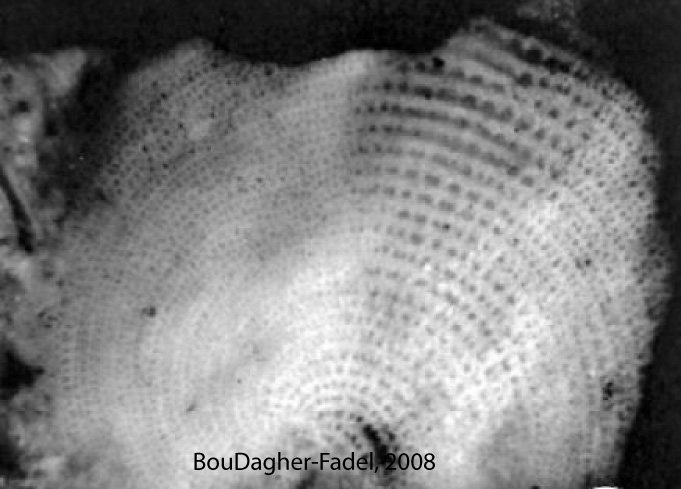 |
Test: flabelliform, with a large undivided globular
proloculus followed by a planispiral evolute stage. There are subepidermal, vertical and transverse partitions resulting in a polygonal meshwork near the interior margins of the chambers.
Geologic range: Late Cretaceous
|
![]() 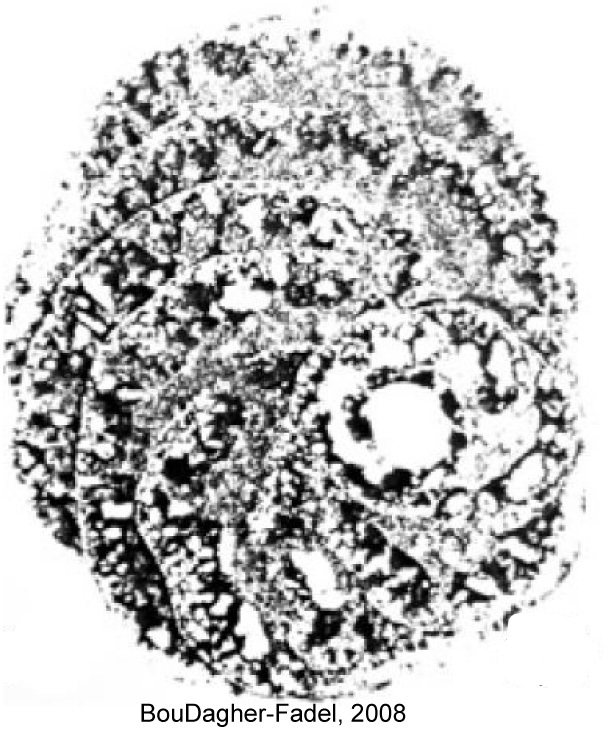 |
Test: flabelliform with high chambers.
Septa: as complex and thick as the hypodermis of wall.
Geologic range: Early Cretaceous
|
Family Loftusiidae
- Test: globose to fusiform with septula perpendicular to septa, and parallel to coiling direction. An alveolar hypodermis is weakly or fully developed.
- Septa: subepidermal reticulate mesh absent.
- Geologic range: Late Cretaceous to ?Eocene
![]() 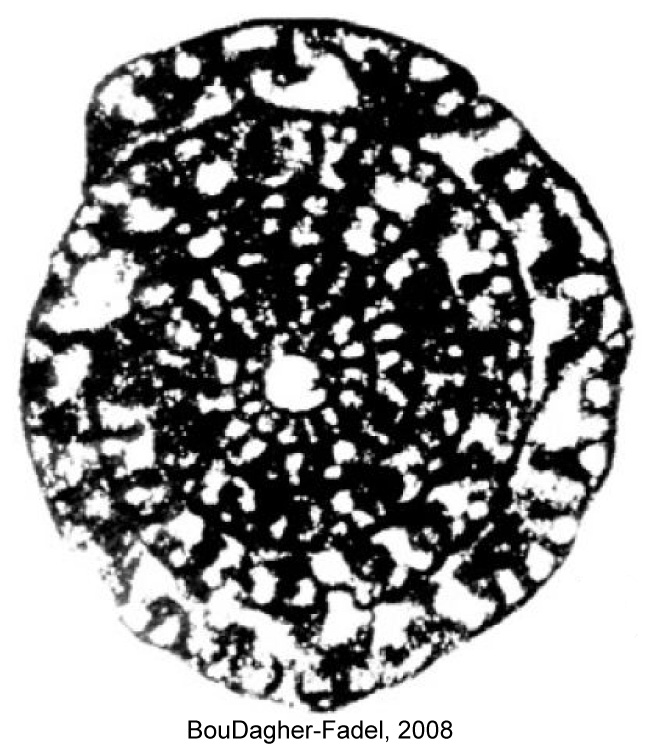 |
Test: globose, spherical with interseptal horizontal lamellae and weakly developed alveolar hypodermis. Septulae aligned from chamber to chamber, but without a basal pre-septal canal. There is a pre-septal tunnel at top of septum.
Geologic range: Early Cretaceous
|
![]() 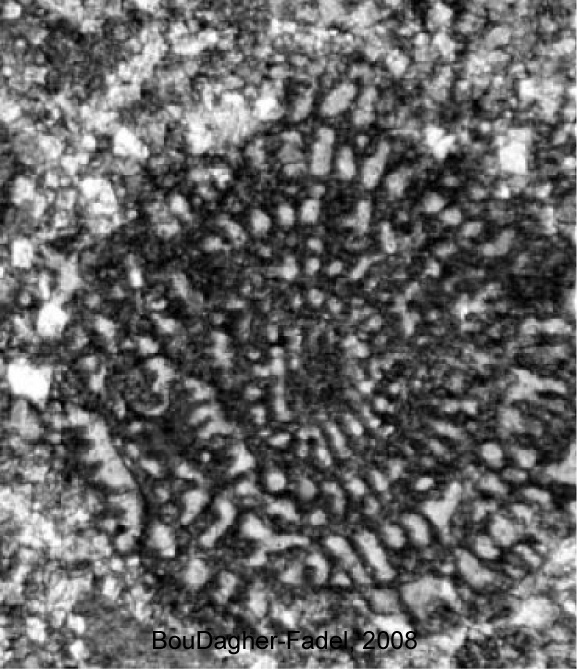 |
Test: globose, spherical with interseptal horizontal lamellae and weakly developed alveolar hypodermis.
Secondary septulae intercalated between primary septulae in later chambers. Pre-septal canal at base of septum.
Geologic range: Late Cretaceous
|
![]() 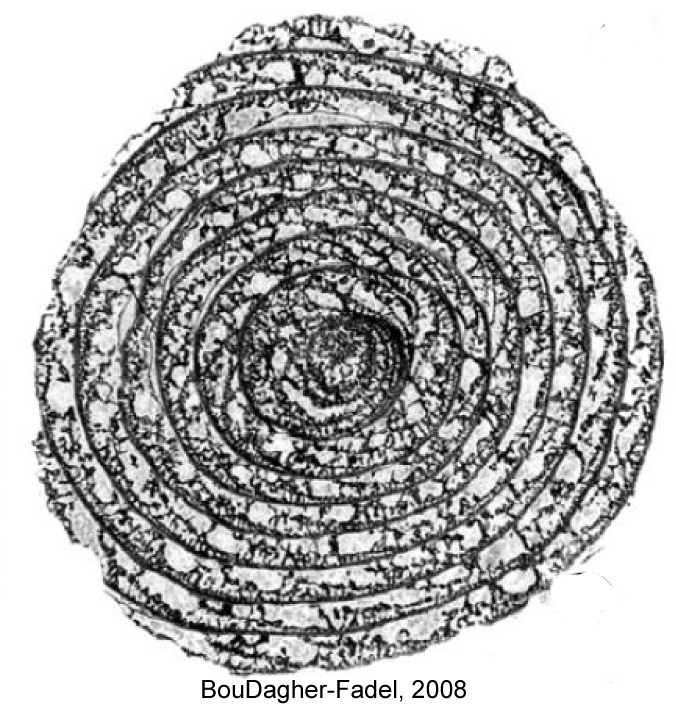 |
Test: Irregularly fusiform or cylindrical in shape and may have either rounded or pointed ends. It is made of a series of chambers that are planispirally coiled around an elongate axis. The front end of each chamber slopes gently down to meet the previous whorl. The portion behind the frontal slope merges smoothly with the previous chamber at the point where its own frontal slope merges smoothly into the area of equal elevation. The interiors of the chambers are partially filled by networks of irregular projections that cover the inner surface of thebexterior walls
Geologic range: Late Cretaceous to ?Eocene
|
Family Lituolidae
- Test: early stages enrolled, but later may become rectilinear.
- Wall: agglutinating foreign particles. Few chambers (less than 10) per whorl.
- Geologic range: Carboniferous to Holocene
Subfamily Ammomarginulininae
- Test: early stage coiled, later uncoiling
- Aperture: single
- Geologic range: Carboniferous to Holocene
![]() 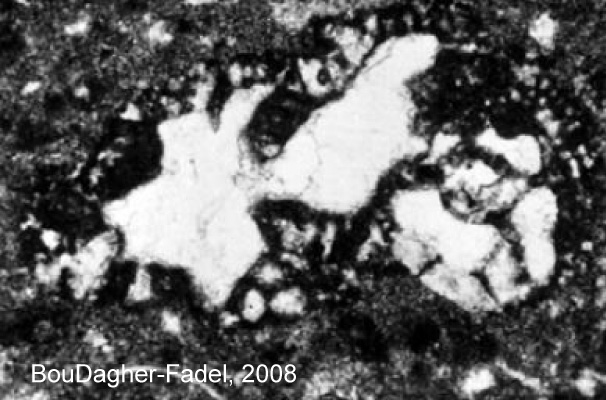 |
Test: simple, not compressed and uncoils in the adult.
Aperture: single, areal.
Geologic range: Carboniferous to Holocene
|
Subfamily Lituolinae
- Test: Members differ from Ammomarginulininae in having a multiple aperture.
- Geologic range: Late Triassic to Holocene
![]() 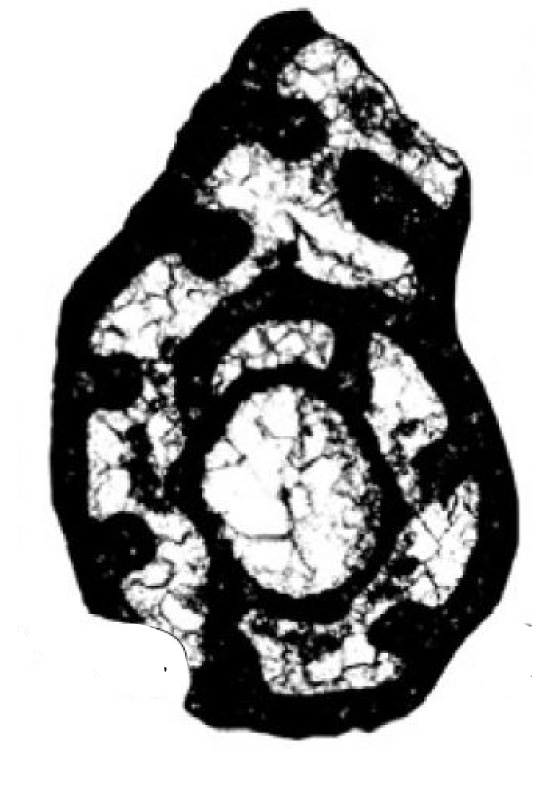 |
Test: These forms have no internal partitions and a multiple cribrate aperture.
Geologic range: Late Triassic to Holocene
|
Superfamily PFENDERINOIDEA
- Test: trochospiral throughout or may become uncoiled. Some forms have a siphonal canal, others develop a central composite columella with pillars between the apertural plates and septa.
- Geologic range: Early Jurassic to Cretaceous
Family Pfenderenidae
- Test: loose trochospiral with siphonal canals that connect successive apertures in primitive forms. Some forms develop a central composite columella, composed of thickened innermost septal ends (‘‘septal buttons’’) with or without additional pillars and a spiral canal between the columella and the thickened septa. A subcameral tunnel (either simple or multiple) is present in advanced forms.
- Chamber interior: advanced taxa have subdivided vertical or horizontal exoskeletal partitions resulting in a reticulate subepidermal layer
- Aperture: always cribrate, areal
- Geologic range: Early Jurassic to Late Cretaceous
Subfamily Kurnubiinae
- Test: without subcameral tunnels, and may or may not have a solid core. The peripheral zone is divided by radial partitions.
- Geologic range: Late Cretaceous
- Genera: Gyroconulina
Superfamily ATAXOPHRAGMIOIDEA
- Test: multilocular, trochospiral that becomes biserial or uniserial in later stages
- Geologic range: Middle Triassic to Holocene
Family Ataxophragmiidae
- Test: initially trochospirally enrolled, often triserial or biserial with no continuous composite central columella
- Aperture: high and terminal
- Geologic range: Late Triassic to Paleocene
![]() 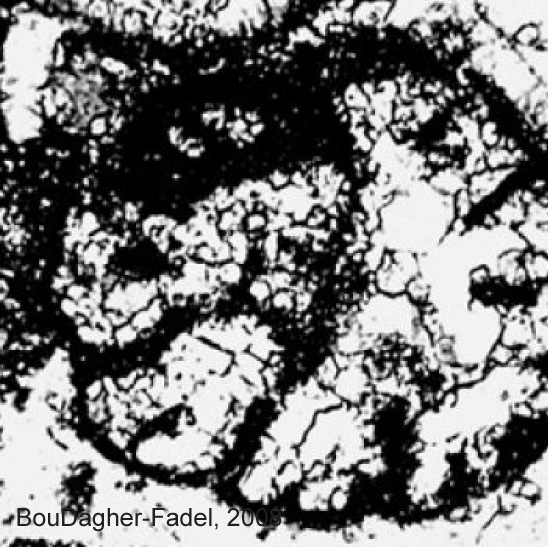 |
Test: shape is similar to Ataxophragmium but the
interior of the chamber is subdivided by numerous buttresses of internal partial partitions, that form distinct chamberlets.
Geologic range: Cretaceous
|
![]() 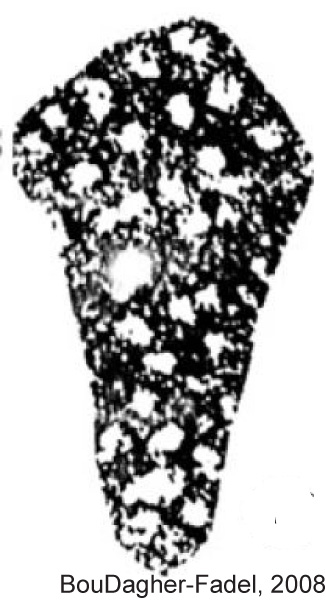 |
Test: trochospirally enroled with whorls
enlarging rapidly. It has thick walls with the interior of the chambers being subdivided by numerous arched peripheral partitions. Often they have intercalary
buttresses attached to the outer wall that may meet to form irregular chamberlets.
Geologic range: Cretaceous
|
Family Cuneolinidae
- Test: conical to subflabelliform, trochospiral in early stage with as many as five chambers per whorl, rapidly reduced to biserial
- Chambers: subdivided by radial partitions and may have horizontal partitions.
- Aperture: simple slit or series of pores along the base of the final chamber face.
- Geologic range: Middle Triassic to Late Cretaceous
![]() 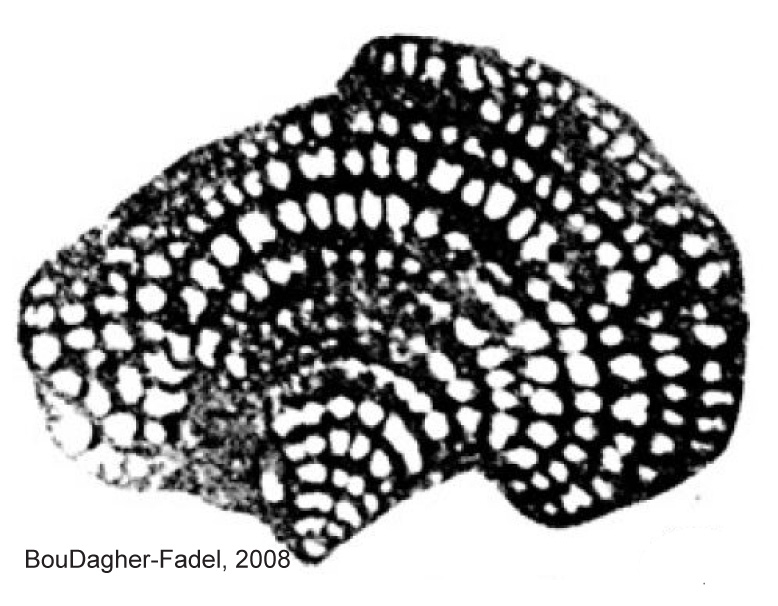 |
Test: compressed. Interior of the chambers: divided
into nearly rectangular chamberlets by both vertical and horizontal partitions perpendicular to the outer wall.
Aperture: an aligned series of pores, along the
base of the final chambers
Geologic range: Early Cretaceous
|
![]() 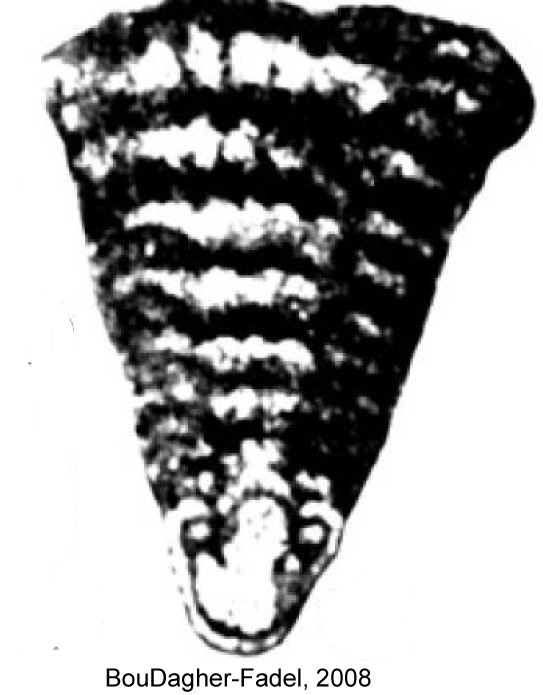 |
Test: with flattened base, small initial trochospiral of three to four sublobular chambers, followed by later triserial and biserial final stages. Biserial chambers are subdivided by vertical and horizontal partitions resulting in a subepidermal network of chamberlets.
Aperture: a single slit.
Geologic range: Early Cretaceous
|
Family Dicyclinidae
- Test: discoidal with cyclical chambers subdivided by transverse and radial partions that form numerous small chamberlets
- Geologic range: Cretaceous
- Genera: Dicyclina
Superfamily ORBITOLINOIDEA
- Test: conical with numerous chambers, partially subdivided by radial or transverse partitions or with pillars
- Geologic range: Early Cretaceous to Oligocene
Family Orbitolinidae
- Test: Forms have an initial low trochospire, that is usually very much reduced and later is rectilinear, broad and conical. They have low uniserial chambers, subdivided with pillars or vertical partitions.
- Aperture: cribrate
- Geologic range: Early Cretaceous to Oligocene
Subfamily Dictyoconinae
- Test: The embryonal apparatus consists of a protoconch and deuteroconch. Major groups are divided into those with no complex central zone, those with complex central zone and radial partitions, those with radial partitions that form a reticulate zone in the transverse section and those with zigzagging radial partitions, giving a stellate appearance in transverse section
- Geologic range: Early Cretaceous to Oligocene
![]() 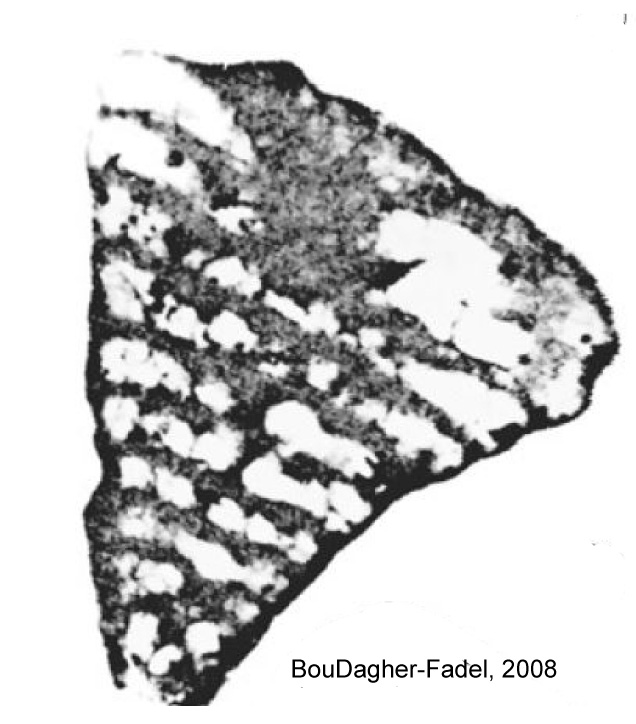 |
Test: Radial partitions alternate in successive
chambers and extend from periphery to the center, with an areal aperture.
Geologic range: Early Cretaceous
|
![]() 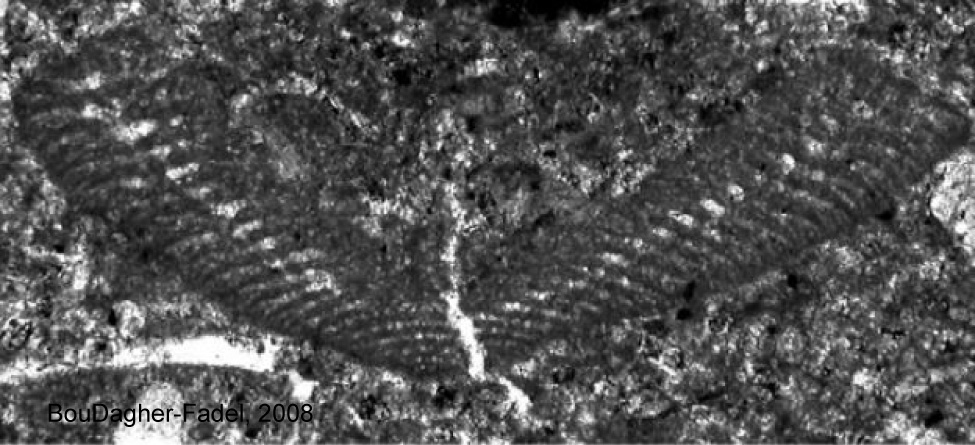 |
Test: The cyclic chambers in the median zone aresubdivided into chamberlets by long radial partitions, thickening towards the lower side of the test, but leaving a large undivided zone.
Geologic range: Late Cretaceous
|
![]() 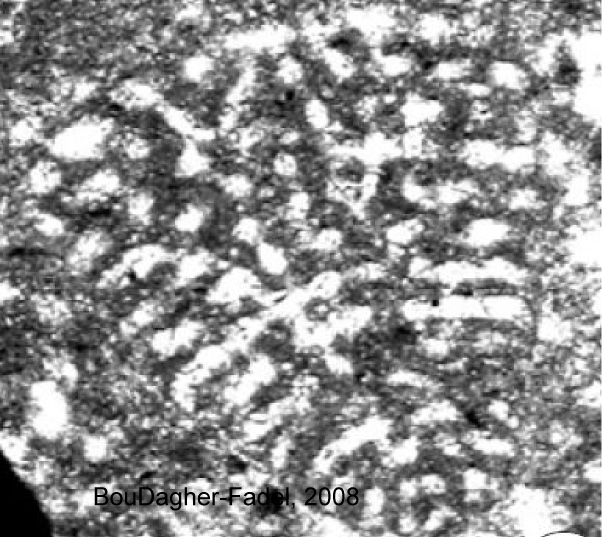 |
Test: Without tiers of peripheral rectangular
chamberlets.
Geologic range: Early Cretaceous
|
![]() 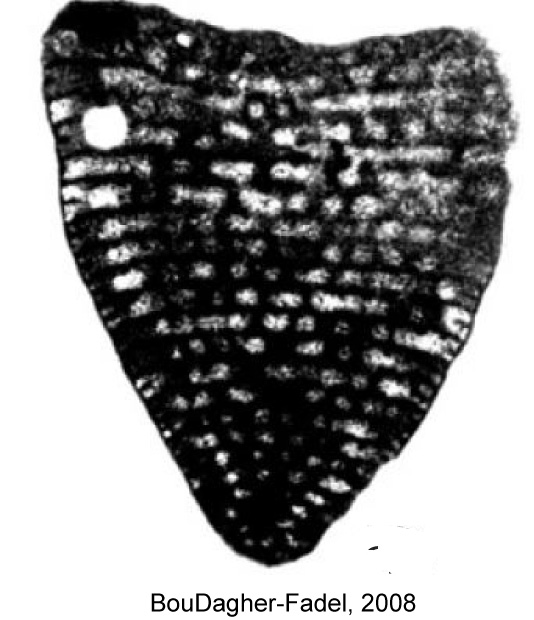 |
Test: With peripheral tiered rectangular chamberlets.
Geologic range: Early Cretaceous to Oligocene
|
![]()  |
Test: With main partitions that are reticulate in central
area with transverse interconnections.
Geologic range: Early Cretaceous
|
![]()  |
Test: Without tiers of peripheral chamberlets
Geologic range: Early Cretaceous
|
![]() 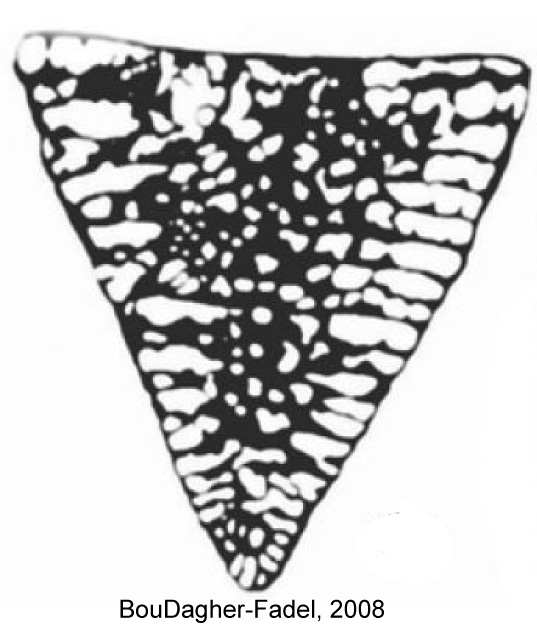 |
Test: Without tiers or peripheral chamberlets.
Geologic range: Early Cretaceous
|
![]() 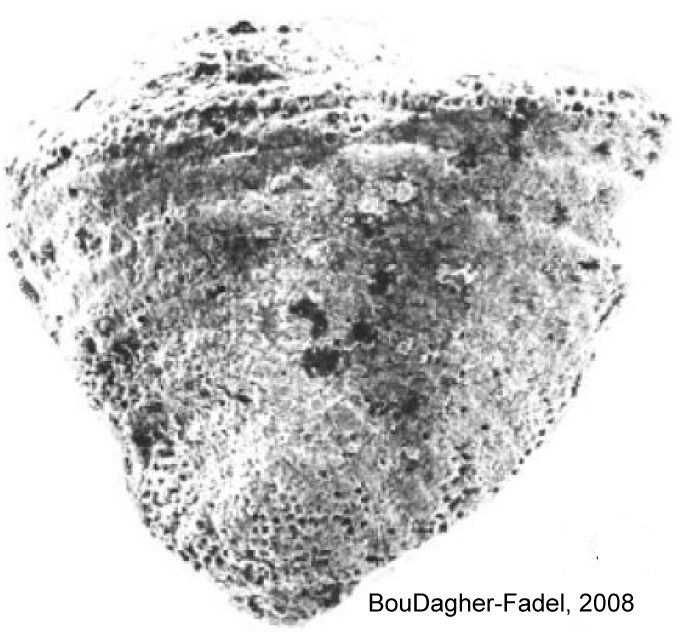 |
Test: laterally compressed, but with a central zone having pillars. With tiered peripheral chamberlets.
Geologic range: Late Cretaceous
|
![]() 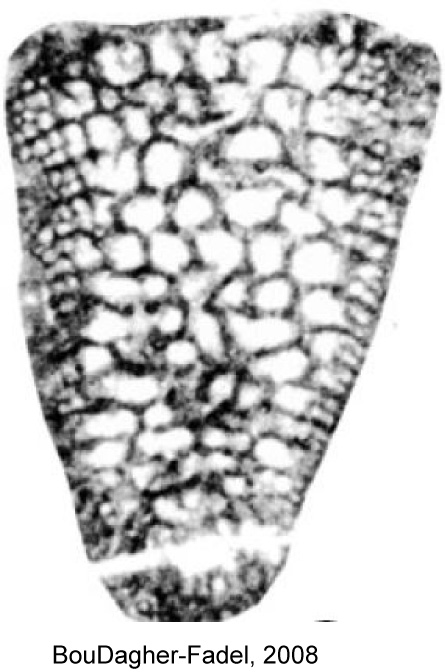 |
Test: Large proloculus divided into a protoconch
and deuteroconch with the marginal zone becoming extensively divided by vertical and horizontal partitions.
Geologic range: Cretaceous
|
![]() 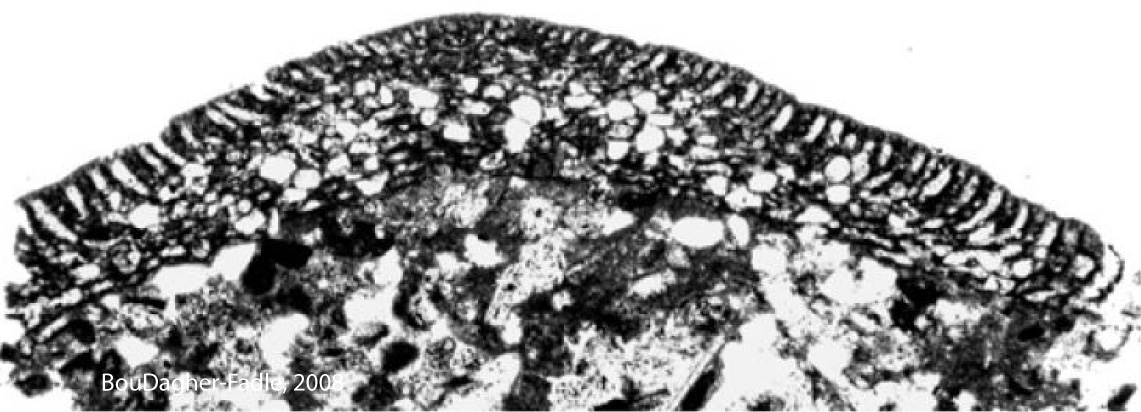 |
Test: Large apically situated embryonic apparatus.
The deuteroconch is about three times thicker than the subembryonic zone and both are subdivided by radial beams. Zigzag radial partitions occur in the
central zone and there is a series of marginal and vertical plates.
Geologic range: Cretaceous
|
![]() 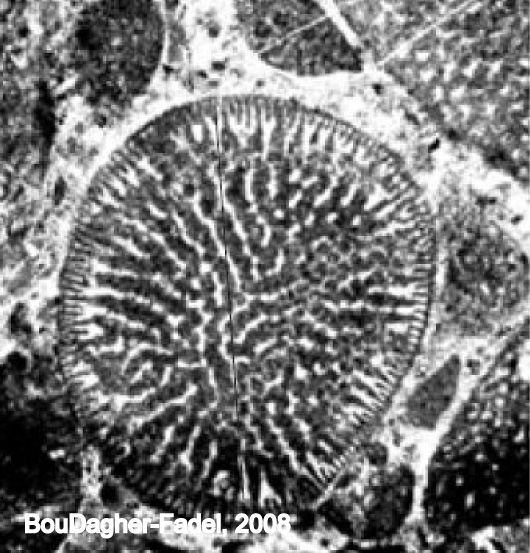 |
Test: Apically situated embryonic zone in which the
deuteroconch and subembryonic zone are of more or less equal thickness. Both are subdivided by vertical exoskeletal beams.
Geologic range: Early Cretaceous
|
![]() 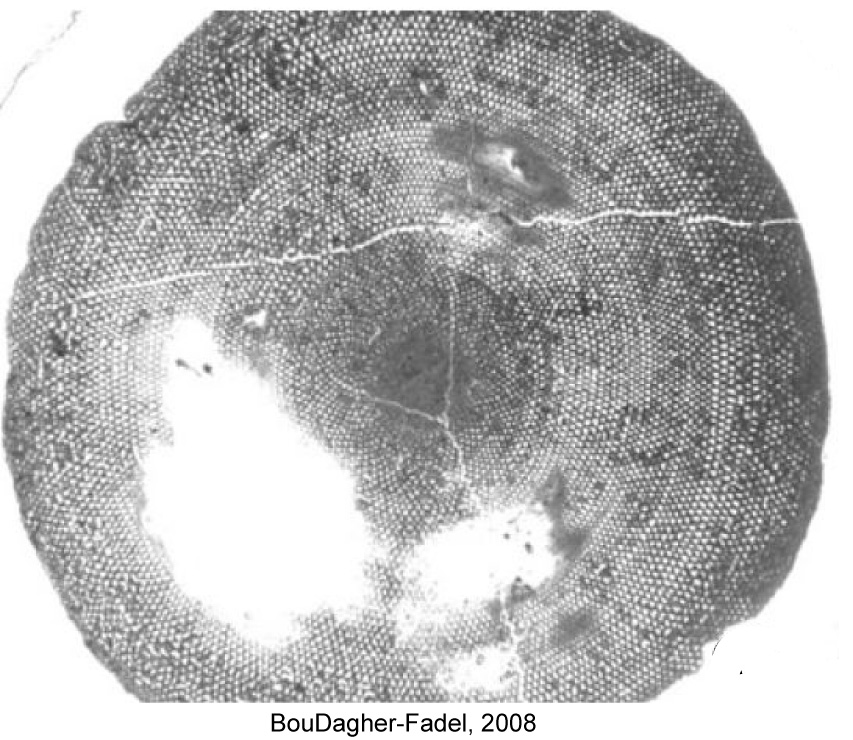 |
Test: Large, apically sited, globular, fused protoconch and deuteroconch forming a relatively simple embryonic apparatus, which can be surrounded by a peri-embryonic ring of obliquely arranged chamberlets.
Geologic range: Early Cretaceous
|
Family Chrysalidinidae
- Test: high trochospiral, with quinqueserial or quadriserial or triserial or biserial coiling modes, or with certain consecutive pairs of these.
- Aperture: central along the axis of coiling. In quadriserial or quinqueserial forms, an umbilicus is present and the aperture is covered with a broad umbilical flap, which may be penetrated by multiple accessory apertures. Internal pillars may develop between successive intraumbilical flaps.
- Geologic range: Subfamily Chysalidinina: Cretaceous.
- Geologic range: Subfamily Paravalvulininae: Jurassic (see Jurassic section)
Subfamily Chrysalidininae
- Test: triserial throughout its ontogeny, becoming biserial or quadriserial in the adult
- Wall: solid but sometimes becoming canaliculate
- Geologic range: Early Jurassic to Late Eocene
- Genera: Praechrysalidina; Dukhania; Chysalidina; Accordiella
Superfamily CYCLOLINOIDEA
- Test: cyclical chambers filled with numerous radial pillars
- Geologic range: Late Jurassic to Late Cretaceous
Family Cyclolinidae
- Test: shows annular or cyclical adult chambers that may be subdivied by pillars or partitions
- Geologic range: Cretaceous
Subfamily Cyclopsinellinae
- Test: cyclical chambers, median region with numerous radial pillars but there are no subdivisions present in the external subepidermal area. A radial stolon system is present.
- Geologic range: Late Jurassic to Late Cretaceous
- Genera: Cyclopsinella; Mangashtia
Subfamily Ilerdorbinae
- Test: The outer parts of the chambers are subdivided by secondary partitions.
- Aperture: Alternate in position from chamber to chamber, producing an oblique stolon system.
- Geologic range: Cretaceous
- Genera: Dohaia; Eclusia
SUBORDER ROTALIINA
- Test: multilocular with a calcareous wall, made of perforate hyaline lamellar calcite
- Aperture: either simple or has an internal toothplate
- Geologic range: Triassic to Holocene
Superfamily PLANORBULINOIDEA
- Test: trochospiral in early stages, later stages may be uncoiled and rectilinear or biserial or with many chambers in the whorl.
- Aperture: intra- to extraumbilical, but additional equatorial apertures may be present.
- Geologic range:Early Cretaceous to Holocene
Family Cymbaloporidae
- Test: Chambers occur in a single layer
- Geologic range: Late Cretaceous to Holocene
![]() 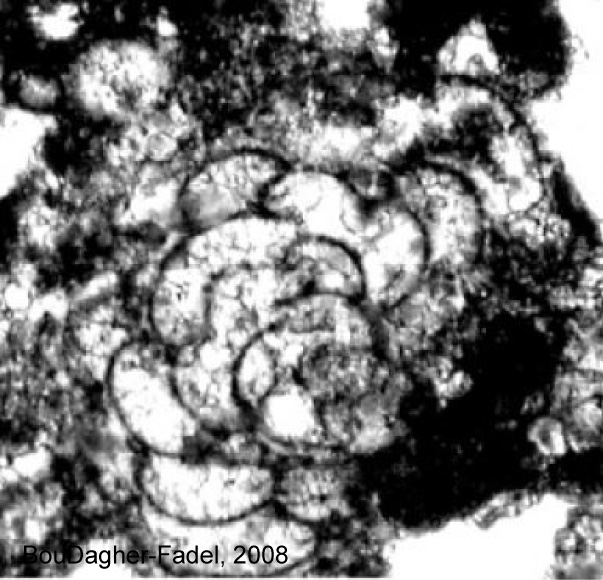 |
Test: with a large proloculus, followed by an enroled
stage of 5 chambers per whorl, later chambers occur in an annular series.
Geologic range: Late Cretaceous
|
Superfamily ORBITOIDOIDEA
- Test: discoidal to lenticular with prominent dimorphism, in most orbitoidal speciesboth megalospheric and microspheric generations are found. Microspheric specimens occur with a distinctly small protoconch (usually about 20 mm), but megalospheric forms have a distinctive embryonic stage, enclosed in a thicker wall. Equatorial and lateral chambers may be differentiated or indistinguishable.
- Geologic range: Late Cretaceous to Oligocene
Family Orbitoididae
- Test: large lenticular, non-canaliculate, composed of a median layer, comprising the initial stage surrounded by concentrically arranged equatorial chambers and flanked by layers of lateral chamberlets. The embryonic chamber usually consists of two chambers (a globular first chamber or protoconch and a reniform second chamber or deuteroconch) surrounded by a relatively thick wall that is in turn surrounded immediately by equatorial chambers, called peri-embryonic chambers. The third chamber is called an auxiliary chamber, and in advanced species, there may be two auxiliary chambers. Stolons (apertures) are present and connect the equatorial chambers. Most genera of Cretaceous orbitoidal foraminifera are ornamented with rounded pustules.
- Geologic range: Late Cretaceous
Below is a figure after BouDagher-Fadel (2008) illustrating the different lineages of the orbitoids. The shaded boxes highlight forms found only in the Caribbean Province.
Subfamily Orbitoidinae
- Test: Lateral chambers may be present and differentiated from the equatorial layer in the post embryonal stage.
- Geologic range: Late Cretaceous
- Genera: Orbitoides; Monolepidorbis; Pseudomphalocyclus; Simplorbites
![]() 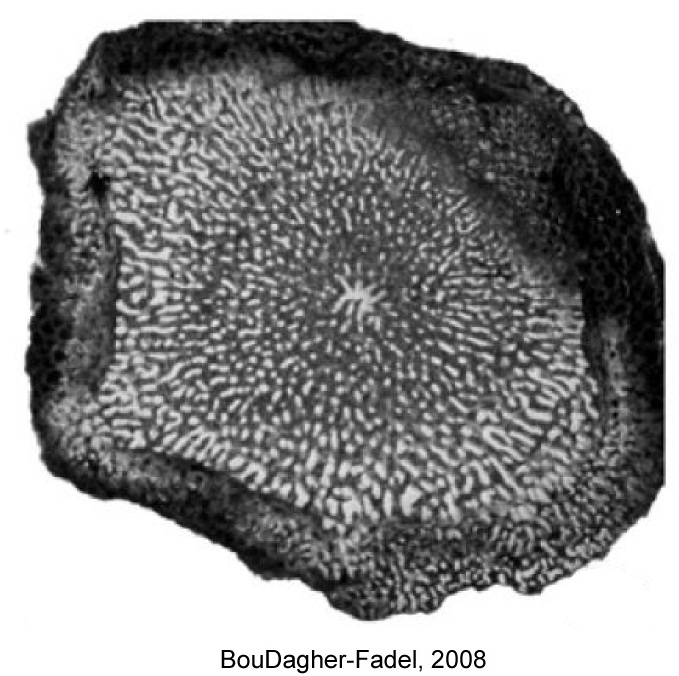 |
Test: made up of a single, roughly flat layer of large chambers (the median layer) with a mound of much smaller chambers on either sides (the lateral chambers). In plan view, the test is slightly asymmetric, usually with a central knob on one side and radial ridges on the test. In the central part of the median layer, there is a group of two to four chambers with thin and straight mutual walls, the whole enclosed within a thick and conspicuously porous outer wall. Stolons are big enough to be observed in vertical sections.
Geologic range: Late Cretaceous
|
![]() 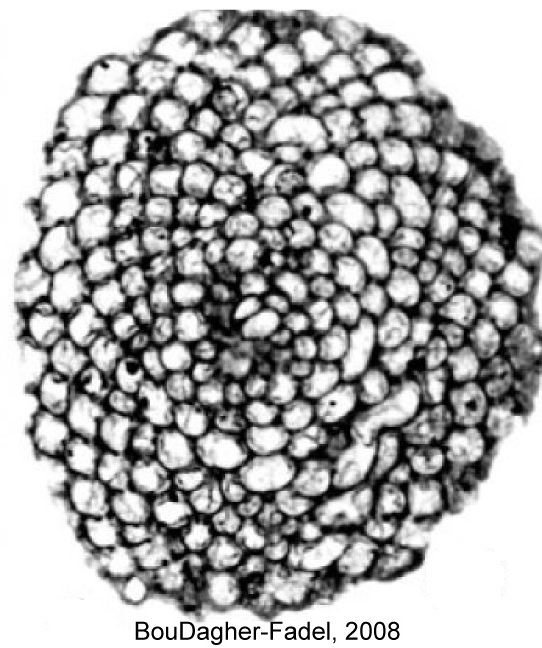 |
Test: Monolepidorbis differs from Orbitoides by the absence of lateral chamberlets. However, long incipient lateral chamberlets may be present.
Geologic range: Late Cretaceous
|
Subfamily Omphalocyclinae
- Test: lateral chambers are not differentiated from equatorial layer in the post-embryonal stage
- Geologic range: Late Cretaceous
- Genera: Omphalocyclus; Torreina
Family Hellenocyclinidae
- Test: orbitoid but lacking lateral chamberlets
- Geologic range: Late Cretaceous
- Genera: Hellenocyclina
Family Lepidorbitoididae
- The Lepidorbitoidae differ from the Orbitoididae by the different character of their embryonic apparatus and by the form of their median chambers. An embryonic stage with two chambers is followed by hexagonal or arcuate equatorial chamberlets and by differentiated lateral chambers.
- Geologic range: Late Cretaceous to Middle Eocene
- Genera: Arnaudiella; Clypeorbis; Helicorbitoides; Lepidorbitoides; Pseudosiderolites; Sirtina; Sulcoperculina; Vanderbeekia (refer to figure above)
This figure illustrates the three lineages that evolved from Sulcoperculina in the Late Cretaceous
Superfamily ROTALIOIDEA
- Test: involute to evolute, initially trochospiral or planispiral, commonly with many chambers in numerous whorls. As new chambers are added, septal flaps attach to previous apertural faces and enclose radial canals, fissures, umbilical cavities and intraseptal and subsutural canals.
- Wall: perforate, hyaline calcite and generally optically radial in structure.
- Aperture: single or multiple with small opening into the canal system may occur along the sutures
- Geologic range: Late Cretaceous to Holocene
Family Pseudorbitoididae
- Test: lenticular, canaliculated with a two-chambered embryo followed by a spire of nepionic chambers. This group is characterized by the presence of a structure of radially arranged calcareous elements in the equatorial layer.
- Geologic range: Late Cretaceous
Subfamily Pseudorbitoidinae
- Test: The equatorial (median) layer is subdivided vertically by variously arranged radial plates or rods.
- Geologic range: Late Cretaceous
- Genera: Conorbitoides; Historbitoides; Pseudoorbitoides; Sucorbitoides (see figure below)
Subfamily Vaughaninae
- Test: Juvenile stage is similar to Sulcoperculina, developing lateral chambers but equatorial layers are similar to the pseudorbitoids
- Geologic range: Late Cretaceous
- Genera: Aktinorbitoides; Ctenorbitoides; Vaughanina (refer to illustrations above)
Subfamily Pseudorbitellinae
- Test: Pseudorbitoidal structure but lacks plates
- Geologic range: Campanian to Maastrichtian
- Genera: Asterorbis; Orbitocyclina (refer to illustrations above)
Family Calcarinidae
- Test: enrolled with large inflated spines
- Geologic range: Late Cretaceous to Holocene
![]() 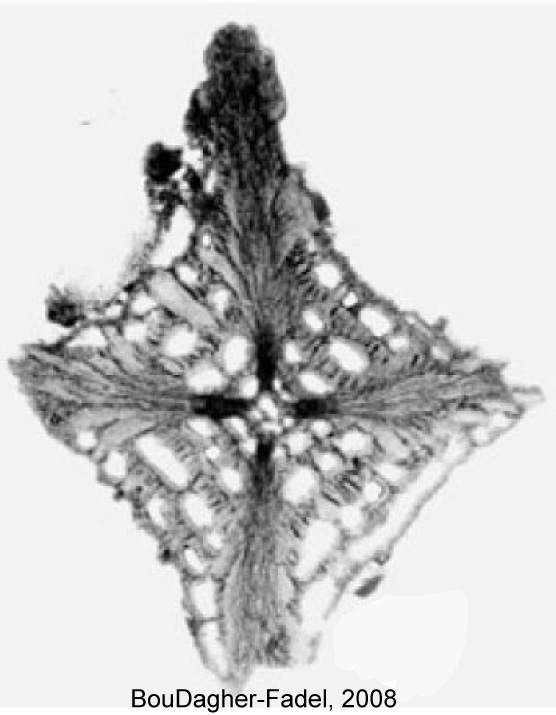 |
Test: large with a globular proloculus followed by an
involute coil of about four whorls. In the final whorl two to seven large coarse spines are present. Spiral canals occur in the umbilical region on both sides of the test. Pillars appear in the umbilical region as solid pustules.
Geologic range: Cretaceous
|
SUBORDER MILIOLINA
- Test: miliolines that are porcelaneous, imperforate and made of high-magnesium calcite with fine randomly oriented crystals.
- Geologic range: Late Cretaceous
Superfamily ALVEOLINOIDEA
- Test: enrolled along an elongate axis, initially planispiral or streptospiral, or milioline with chambers added in varying planes
- Geologic range: Cretaceous to Holocene
This figure illustrates the evolution of the Alveolinoidea in the Cretaceous
Family Fabulariidae
- Test: large, dimorphic, multichambered with a milioline coiling, tending to become reduced in subsequent growth stages, either to bilocular or to monolocular chamber cycles with a trematophore as aperture.
- Chambers: thickened basal layer, subdivided by pillars or secondary partitions
- Geologic range: Late Cretaceous to Early Oligocene
- Genera: Adrahentina; Lacazina; Pseudochubbina; Pseudolacazina
Family Rhapydioninidae
- Test: planispiral to streptospiral in early stage to uncoiled compressed, peneropliform- flaring or cylindrical in later stages. Embryonal apparatus: simple or milioline. Central zone: with canaliculated thickening except for a pre-septal space with buttresses (residual pillars).
- Aperture: multiple on the final chamber face
- Geologic range: Late Cretaceous
![]() 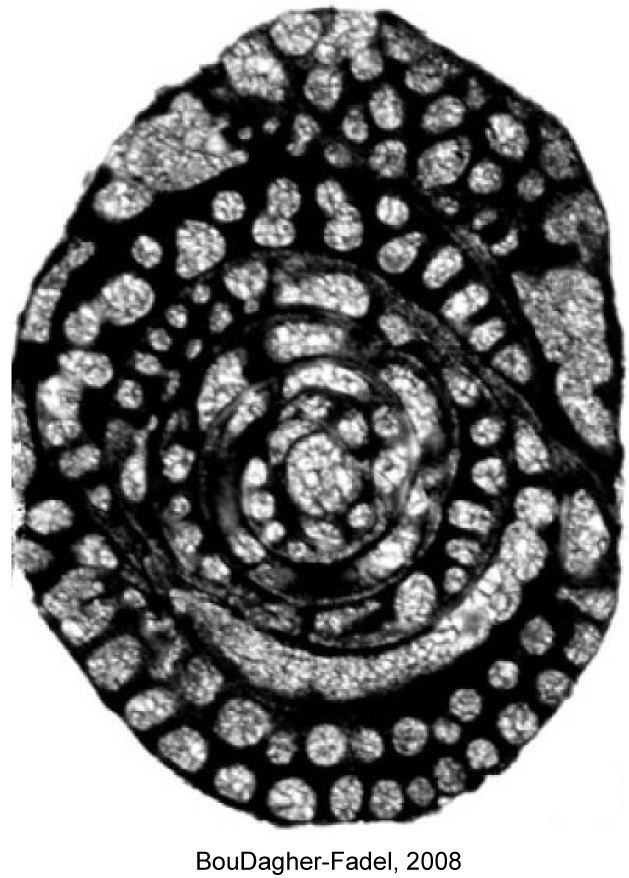 |
Test: large globular and streptospiral, later flaring planispiral and peneropline.
Interior of chambers:subdivided by numerous septula.
Geologic range: Late Cretaceous
|
![]() 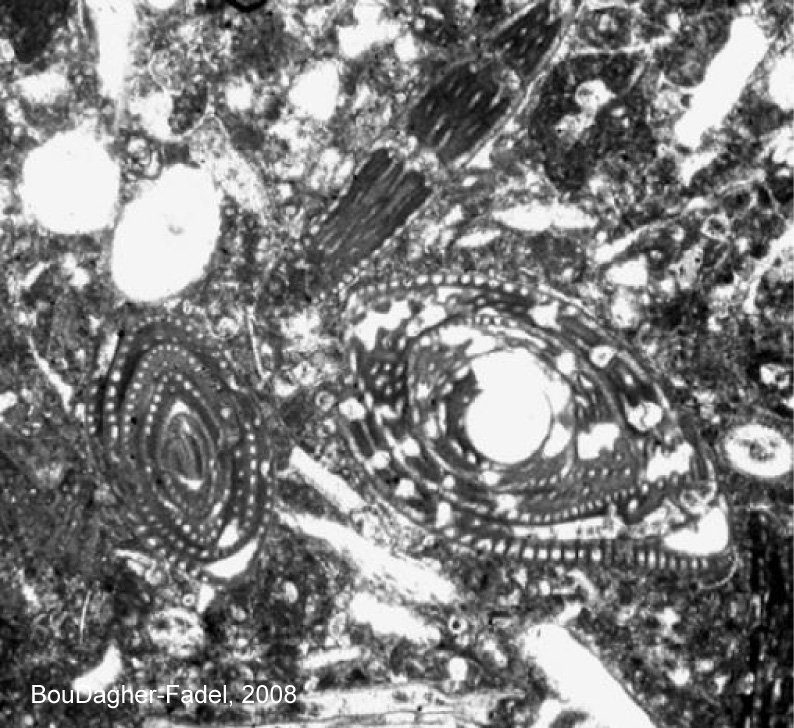 |
Test: planispiral and involute, later uncoiling and
rectilinear. Horizontal and vertical septa subdivide the chambers into secondary chamberlets.
Geologic range: Late Cretaceous
|
![]()  |
Test: globular to lenticular with last chambers becoming progressively longer and strongly overlapping the preceding chambers until they become cyclical with compressed arched chambers in its final whorls.
Geologic range: Late Cretaceous
|
Family Alveolinidae
- Test: free, large, planispiral to fusiform, cylindrical or globular, coiled about elongate axis.
- Chambers: divided into chamberlets by secondary septa (septula) perpendicular to the main septa, and connected along the chamber by passages.
- Chambers: divided into chamberlets by secondary septa (septula) perpendicular to the main septa, and connected along the chamber by passages.
- Apertures: numerous, circular, in horizontal rows
- Geologic range: Early Cretaceous to Holocene
- Genera: Archaealveolina; Cisalveolina; Helenalveolina; Multispirina; Ovalveolina; Praealveolina; Senalveolina; Simplalveolina; Streptalveolina; Subalveolina
Superfamily SORITOIDEA
- Test: planispiral, uncoiling, flabelliform or cyclical, and may be subdivided
by partitions or pillars
- Geologic range: Late Permian to Holocene
Family Meandropsinidae
- Test: planispiral to annular discoid, laterally compressed, involute with partially developed partitions. Numerous septula divide the interior of the chambers.
- Aperture: multiple
- Geologic range: Late Cretaceous
- Genera: Ayalaina; Broeckina; Fallotia; Larrazetia; Meandrospina; Nummofallotia; Pastrikella; Perouvianella; Pseudobroeckinella; Spirapertolina
This figure illustrates the development of Meandrospina
Family Soritidae
- Test: involute, planispiral to uncoiled evolute, flaring, annular discoid with partial or complete partitions
- Aperture: multiple
- Geologic range: Late Cretaceous to Holocene
- Genera: cycledomia; Edomia; Lamarmorella; Murgella; Pseudorhapydionina; Pseudorhipidionina; Scandonea; Taberina; Zekritia
Family Keramosphaeridae
- Test: globular with concentric chambers connected by stolons in the same series as
- well as those of successive series.
- Geologic range: Early Cretaceous, Miocene to Holocene
- Genera: Keramosphaerina; Pavlovecina
References
BouDagher-Fadel, M.K., 2008. Evolution and Geological Significance of Larger Benthic Foraminifera. Developments in Paleontology and stratigraphy, v. 21, 540p.